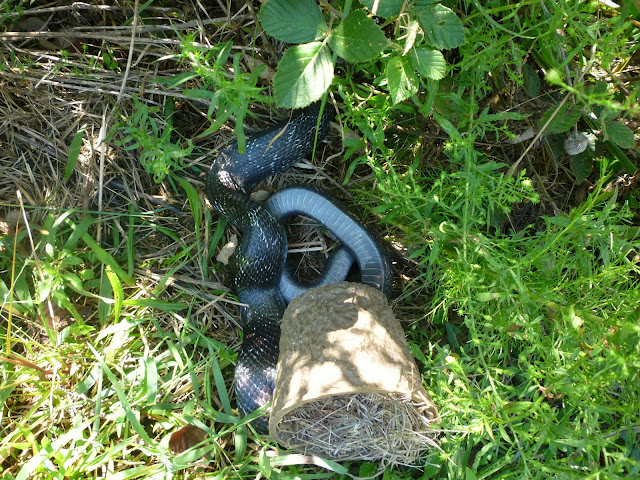Late September wood warbler migrants bring a surprising discovery.
After delivering a second dead wood warbler to the "wet lab" at Prairie Ridge Ecostation on Monday (see end of this post), I took a short walk along a couple of the trails there. I came upon a nesting box with a decorative flag fluttering in the gentle breeze.
 |
| This is bird nesting box #4 at Prairie Ridge EcoStation. Do you see the "decorative flag" hanging from the nesting box mounting pole? |
I noticed that the front door of the nesting box was open a little bit at the bottom and tried to close it, but it wouldn't close easily. So I took a little peek in the entrance hole. And here is what I saw!
 |
| I just had to see a little more of this snake so I opened the front of the nesting box. You can see a little of the snake's thickness and the flat scales on its side. |
 |
| In a flash the nest cup fell out of the nesting box and onto the ground with the snake not far behind. See how shiny it is? You can also see some sprinkling of white between the scales on its back and sides and its dark gray belly. Baby black rat snakes are strongly patterned. The adult snakes like this nearly six foot long individual still show a little of that pattern between their black scales. The snake quickly slithered off into the thicket of prairie grasses and plants. It had been a surprise for me and, well, for the snake, too. But you know me, it was a wonderful surprise to see such a healthy reptile in late September.
A fellow blogger (Tyler) suggested that this might be a Black Racer because its scales appear to be smooth and not keeled (ridged). This photo is an enlargement from picture #5. Rat snakes are described as having weakly keeled scales. Although most of this snake's scales looked pretty smooth, some of the scales at the lower left of this photo show a hint of a ridge (keel) along the center. Black Racers look very similar to Black Rat Snakes, but are described as having smooth scales. All comments are welcome.
Wood Warblers for the museum This is the fall Yellow Warbler that I took to Prairie Ridge for their bird collection. At Prairie Ridge the bird was put in a plastic bag and placed in a freezer. At some future time the bird may be mounted or its skin and feathers preserved for teaching students about the identifying marks of the species. It is always sad to lose a bird, but it is important to preserve the dead ones as a way to teach and a way to learn more about them. This bird died when it flew into a window at the lab where I work. It was found and retrieved by a fellow employee who brought it to my desk. It is the time of year that many birds species including neotropical wood warblers migrate to the Caribbean as well as to Central and South America were there are plenty of insects to eat during our winter months. This is the second warbler I delivered to Prairie Ridge. This is a Northern Waterthrush. It flew into the same window as the Yellow Warbler. Another fellow employee found the bird and notified the receptionist to alert me when I arrived at work. Notice the thin beak that is perfect for catching insects. The yellow and brown coloring and pattern of this bird are beautiful to me. Notice the yellow stripe above its eye and the brown streaks on its breast. This warbler is often found near wet areas in the woods, in swamps, and along streams and lakes. |
































